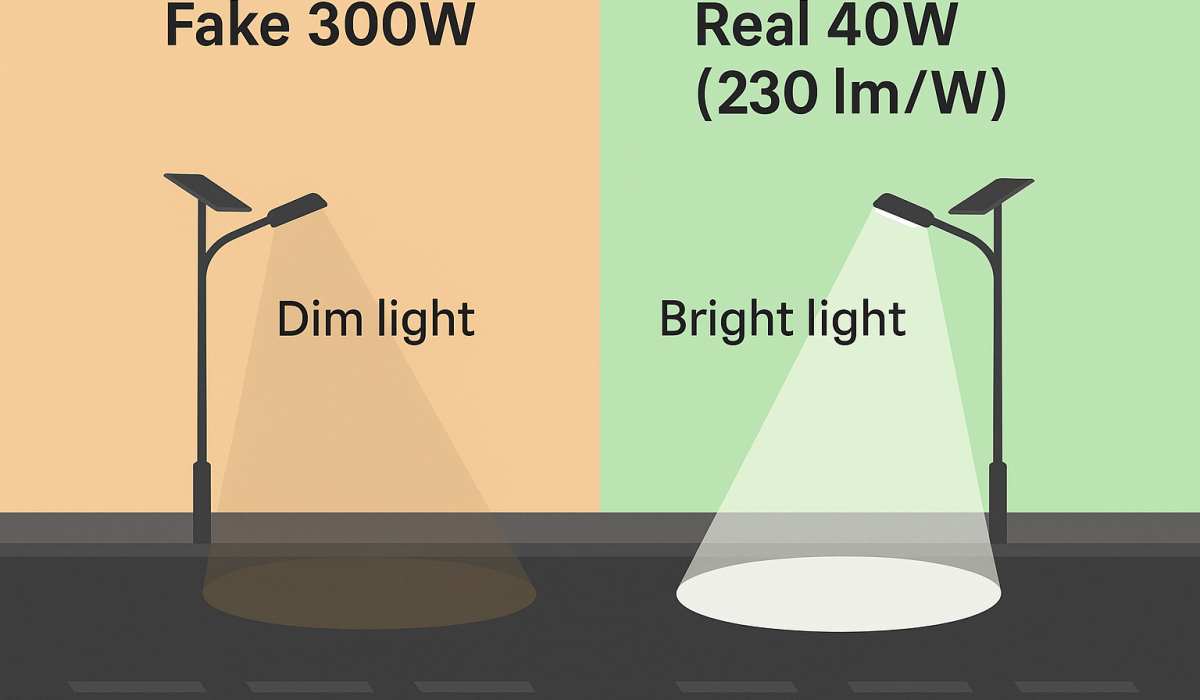When I sit down with EPC contractors or procurement managers across Africa, one recurring question always comes up:
“Why are your solar street lights only 60W, while competitors advertise 200W or 300W?”
It’s a fair question. On paper, bigger wattage looks better. But in practice, the truth is very different. After 15 years of delivering solar lighting projects in African cities—from wide boulevards to secondary roads—I can confirm: a properly designed 60W solar street light outperforms so-called “200W” or “300W” models. Here’s why.
What does “Watt” really mean in solar street lighting?
Watts (W) measure how much power the LED consumes—not how much light it delivers.
Brightness is measured in lumens (lm), which depends on the LED efficiency (lm/W).
- Old technology (2015): 140–160 lm/W → a 100W lamp gave ~14,000 lumens.
- Today’s high-end LED (2024): ≥230 lm/W → a 60W lamp gives ~13,800 lumens.
👉 With modern LEDs, a 60W street light today is as bright as a 100–120W light from 10 years ago.
Why are fake 200W solar lights misleading?
Most low-cost “200W” or “300W” lights flooding the African market don’t actually run at that wattage.
- Inside, the real power is only 30–50W.
- Vendors inflate the watt rating for marketing.
- Buyers think they’re getting “super bright” lights, but in reality, the battery and solar panel can’t support it.
I’ve seen municipalities install 200W-labeled lights that went dark after only a few hours because the design was impossible to sustain.
Result: wasted budget, community complaints, and early replacements.
Why 60W solar street lights are enough for city roads?
1. High LED efficiency
At 230 lm/W, a 60W lamp easily provides 13,000+ lumens, sufficient for 6–8 lane city roads when designed with correct optics.
2. Smart optical design
It’s not just brightness. Good lens design spreads light evenly across the road, meeting M3–M4 lighting standards for urban streets.
3. Sustainable battery and panel match
- 60W system → paired with 150–200W solar panel + 40–60Ah LiFePO₄ battery.
- This ensures 12+ hours lighting for 3 nights backup.
- A real 200W system would need >600W solar panel + 200Ah battery—not practical for pole-top design.
4. Lower lifetime cost
Smaller, optimized wattage =
- Faster installation (30–40 minutes per unit)
- Fewer failures
- 20–30% total cost of ownership (TCO) savings over 10 years
Case Study: 60W Solar Street Lights in West Africa
In 2024, we installed 500 sets of 60W/7m solar street lights for a municipal project.
- LED efficiency: 230 lm/W
- Real delivered brightness: equivalent to a 120W conventional lamp
- Average lighting hours: ≥12h for 3 nights after cloudy days
- Accident rate in the district dropped by 37% within 6 months due to improved night visibility.
👉 The city council originally asked for 150–200W lights. After demonstration, they saw the data and approved 60W. Three years later, the lights still run with minimal maintenance.
Comparison Table: Real 60W vs. Fake 200W
| Parameter | Real 60W (High Efficiency) | Fake 200W (Market Common) |
|---|---|---|
| LED Efficiency | ≥230 lm/W | 100–140 lm/W (low grade) |
| Real Brightness | ~13,800 lm | 3,000–7,000 lm (actual) |
| Battery Life | 5,000–6,000 cycles (LiFePO₄) | <1,500 cycles (cheap cells) |
| Backup Time | ≥3 nights | Often <6 hours |
| Compliance | IEC, UN38.3, IP66 | None |
| Long-Term TCO | 20–30% lower | High due to failures |
Key Takeaway
When evaluating solar street lights:
- Don’t buy watts. Buy performance.
- A well-engineered 60W system can light city roads reliably, sustainably, and cost-effectively.
- “Fake 200W” promises are marketing traps that waste budget and damage credibility with communities.
As EPC contractors, government buyers, or consultants, we must focus on lumen output, optical design, battery backup, and compliance certifications—not just watt labels. That’s how to deliver projects that last 10–15 years and earn public trust.
👉 Next Step: If you’re preparing a tender or project specification, ask for:
- Minimum lm/W efficiency (≥210 lm/W)
- Battery cycle life (≥5,000 cycles, LiFePO₄)
- ≥12 hours lighting for 3 nights backup
This ensures your project gets real 60W performance—not fake 200W disappointment.


